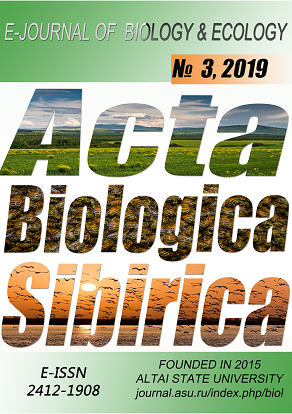Abstract
The composition and content of phenolic compounds in the leaves of Spiraea aemiliana Schneid. from 2 natural populations growing on the Island of Kunashir were studied by HPLC. The chromatographic profiles of S. aemiliana and closely related species S. betulifolia Pall and S. beauverdiana Schneid. were compared. Nineteen compounds were detected in 40 % water-ethanol extracts from the leaves of S. aemiliana. Of these, сhlorogenic, p-сoumaric and cinnamic acids, quercetin, kaempferol, hyperoside, isoquercitrin rutin, avicularin, astragalin and dihydroquercetin (taxifolin) were identified. A specific compound in the leaves of S. aemiliana is isoquercitrin, not identified in other closely related species. The chromatographic profiles of S. aemiliana and S. betulifolia are generally very similar. This is additional evidence of the opinion of scientists about the taxonomic rank of S. aemiliana as a subspecies, variation, or form of S. betulifolia. S. aemiliana (the sum of phenolic compounds varies from 16.4 to 23.,88 mg/g) is more similar to S. beauverdiana in the quantitative content of phenolic compounds. Leaves of S. aemiliana contain a lot of hyperoside (up to 9.50 mg/g), which is almost twice as much as that of S. beauverdiana (up to 4.3 mg/g) and 6 times that of S. betulifolia (up to 1.55 mg/g). The revealed difference in the hyperoside content between the three Spiraea taxa is statistically significant.
References
Ayvazyan S. A. (1989). Prikladnaya statistika: klassifikatsiya i snizheniye razmernosti. Moscow. 607 p. (in Russian).
Glants S. (1998). Mediko-biologicheskaya statistika. Moscow. 459 p. (in Russian).
Grzhibovskiy A.M., Ivanov S.V., Gorbatova M.A. (2016). Sravneniye kolichestvennykh dannykh trekh i boleye nezavisimykh vyborok s ispolzovaniyem programmnogo obespecheniya Statistica i SPSS: parametricheskiye i neparametricheskiye kriterii. Nauka i zdorovye. Metodologiya nauchnykh issledovaniy, 4, 5–36. (in Russian).
Hara H. (1952). Spiraea betulifolia Pall. subsp. aemiliana. (C.K.Schneid.) H. Hara. J. Fac. Sci. Univ. 3, 6, 77.
Kiseleva T.I. Chindyayeva L.N., Tsybulya N.V. (2011). Biologicheskiye osobennosti i antimikrobnyye svoystva vidov roda Spiraea L. v Novosibirske. Vestnik Irkut. gosudar. selskokhoz. akad., 44-1, 65–72. (in Russian).
Klyshev L.K. Bandyukova V.A., Alyukina L.S. (1978). Flavonoidy rasteniy, Alma-Ata, 220 p. (in Russian).
Koidzumi G. (1909). Notes on Japanese Rosaceae. Subfam. I. Spiraeoideae. Bot. Mag., 23, 165–168.
Koropachinskiy I.Yu. & Vstovskaya T.N. (2002). Drevesnyye rasteniya Aziatskoy Rossii. Novosibirsk, 707 p. (in Russian).
Kostikova V.A. & Shaldaeva T.M. (2017). The Antioxidant Activity of the Russian Far East Representatives of the Genus Spiraea L. (Rosaceae Juss.). Russian Journal of Bioorganic Chemistry, 43 (7), 100–104. DOI: 10.1134/S1068162017070081.
Kostikova V.A. (2017). Opredeleniye optimalnykh usloviy ekstraktsii dlya issledovaniya sostava fenolnykh soyedineniy Spiraea betulifolia Pall. metodom HPLC. Khimiya rastitelnogo syria, 1, 159–162. DOI: 10.14258/jcprm.2017011417. (in Russian).
Kostikova V.A., Polyakova T.A. (2014). Eco - Geographical Variability of Spiraea betulifolia Pall. and S. beauverdiana Schneid. on the Morphological and Biochemical Markers. Contemporary Problems of Ecology, 7(3), 315–323.
Kostikova V.A., Filippova E.I., Vysochina G.I., Mazurkova N.A. (2016). Protivovirusnaya aktivnost rasteniy roda Spiraea (Rosaceae), proizrastayushchikh v aziatskoy chasti Rossii. Proceed. Int. Conf. dedicated to 70 years of CSBG SO RAN “Sokhraneniye raznoobraziya rastitelnogo mira v botanicheskikh sadakh: traditsii. sovremennost. Perspektivy”, Novosibirsk, 156–157. (in Russian).
Kostikova V.A., Polyakova T.A. (2018). Morfologicheskaya i biokhimicheskaya izmenchivost rasteniy roda Spiraea L. sektsii Calospira C. Koch. v rossiyskoy chasti areala. Byulleten MOIP, 4, 50–65 (in Russian).
Ohwi J. (1965). Flora of Japan. Washington, 1067 p.
Pavlova L.V. (2015). Ekstraktsionno-khromatograficheskoye opredeleniye fiziologicheski-aktivnykh komponentov tsvetkov “Romashki aptechnoy” i listyev “Evkalipta prutovidnogo”. Thesis of Doctoral Dissertation. Samara, 176 р. (in Russian).
Polozhiy A.V. (1988). Rod Spiraea L. – Tavolga. In Flora Sibiri, 8, 10-20 (in Russian).
Rastitelnyye resursy SSSR: Tsvetkovyye rasteniya. ikh khimicheskiy sostav. ispolzovaniye; Semeystva Hydraginaceae – Haloragaceae. (1987). Leningrad, 99–101. (in Russian).
Sharma D.K., Kim S.G., Lamichhane R., Lee K.H., Poudel A., Jung H.J. (2016). Development of UPLC fingerprint with multicomponent quantitative analysis for quality consistency evaluation of herbal medicine “Hyangsapyeongwisan”. J. Chromatogr. Sci., 54(4), 536–546. DOI: 10.1093/chromsci/bmv182
Singh R. (2016). Chemotaxonomy: A Tool for Plant Classification. Journal of Medicinal Plants Studies, 4(2), 90–93.
Van Beek TA. (2002). Chemical analysis of Ginkgo biloba leaves and extracts. J Chromatogr A, 967, 21–35.
Vatserionova E.O., Kopanina A.V. (2016). Osobennosti struktury molodykh stebley Spiraea beauverdiana v usloviyakh solfatarnykh poley kaldery vulkana Golovnina, ostrov Kunashir. Byulleten Botanicheskogo sada-instituta, 15, 8–10. (in Russian).
Vorobyev D.P. (1968). Dikorastushchiye derevia i kustarniki Dalnego Vostoka. Opredelitel. Leningrad, 278 p. (in Russian).
Vysochina G.I. (2004). Fenolnyye soyedineniya v sistematike i filogenii semeystva grechishnykh. Novosibirsk, 240 p. (in Russian).
Yakubov V.V. (1996). Rod Tavolga – Spiraea L. In Sosudistyye rasteniya Sovetskogo Dalnego Vostoka. Sankt-Petersburg, 8, 130–136 (in Russian).
Zaprometov M.N. (1974). Osnovy biokhimii fenolnykh soyedineniy. Moscow, 213 p. (in Russian).
Acta Biologica Sibirica is a golden publisher, as we allow self-archiving, but most importantly we are fully transparent about your rights.
Authors may present and discuss their findings ahead of publication: at biological or scientific conferences, on preprint servers, in public databases, and in blogs, wikis, tweets, and other informal communication channels.
ABS allows authors to deposit manuscripts (currently under review or those for intended submission to ABS) in non-commercial, pre-print servers such as ArXiv.
Authors who publish with this journal agree to the following terms:
- Authors retain copyright and grant the journal right of first publication with the work simultaneously licensed under a Creative Commons Attribution License (CC BY 4.0) that allows others to share the work with an acknowledgement of the work's authorship and initial publication in this journal.
- Authors are able to enter into separate, additional contractual arrangements for the non-exclusive distribution of the journal's published version of the work (e.g., post it to an institutional repository or publish it in a book), with an acknowledgement of its initial publication in this journal.
- Authors are permitted and encouraged to post their work online (e.g., in institutional repositories or on their website) prior to and during the submission process, as it can lead to productive exchanges, as well as earlier and greater citation of published work (See The Effect of Open Access).


